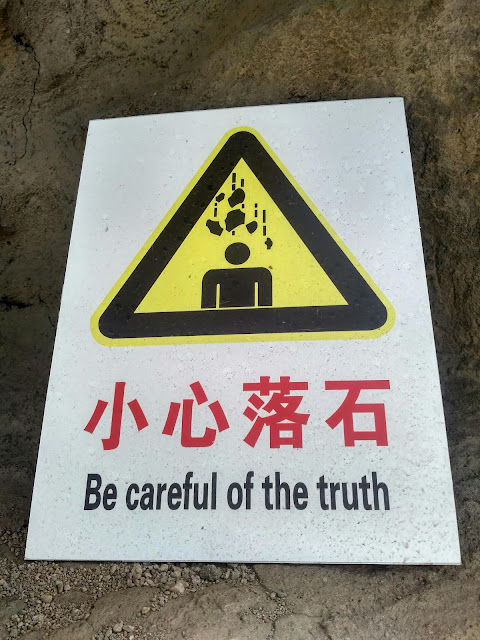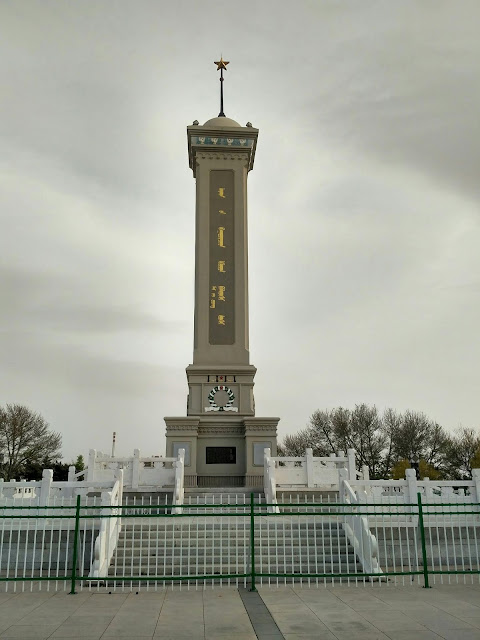We were woken by soft music and fluorescent lights around 05:00, fully an hour before our train arrived at its final stop, Datong.
As far as Chinese cities go, Beijing is just about as easy as they come to travel in, so it was a relief that things still seemed pretty straightforward at level 2 (with level 10 probably being Gaoding down south where no one spoke any English beyond "hello" and a fair few didn't even speak Mandarin.)
The folks at the Datong Youth Hostel in the New Old Town were kind enough to check us in at 07:00 and even convinced us to join another guest on a tour for the rest of day.
Before I get on to that, a word on the "New Old Town." Datong was the capital of the Northern Wei dynasty about 1500 years ago. Other than a few small sections of the mud cores of the old city walls, the imperial structures are all long gone. Inside these scraps of the old city walls, the hutong-like neighbourhoods were authentic, but not particularly photogenic.
Having seen the boon of tourism in places like Xi'an, with its restored old town, the mayor at the time decided that the thing to do was to re-build the old town the way it "ought" to look, from scratch.
The process is still underway, but massive brick city walls, 1.5km on a side have been constructed. Vast swathes of the old rough and ready hutongs have been torn down and replaced with tidier versions of the same things. Or grand buildings that have room to house banquet halls or large department stores. Even the old palace is being rebuilt, at a scale that will rival the Forbidden City.
I'm unsure of what to think of this. All of this is brand new and designed purely to please tourist visitors, but it is really quite pretty.
Anyhow, enough of the New Old, let's get on with the Old Old.
We spent about 1.5 hours in a taxi to two attractions south of the city. With us was Sou Ling (sp?) a young Chinese woman from Xinjiang who had just finished school and was enjoying a holiday in the east before heading home to look for a job. She was our constant companion for the day, which was really very pleasant. We shared snacks, talked (with minor difficulty) about the places we were visiting together. Though she was constantly amused that others at the sites we visited assumed she was our tour guide.
The first spot was the Hanging Temple. Reminiscent of the Sumela Monastery in Turkey, it's built on a cliffside above a rocky valley floor. The place wasn't huge, but it was fun walking along its rickety catwalks and scrambling up and down its many steep stairways. It's a good thing that the hydro dam about 500m up the valley was sites where it was, or the whole place could have ended up under water!
Rather to our surprise, the next stop (which we'd seen as just a bit of a bonus on top of the one we really wanted to see) was probably more enjoyable. At the very least we spent a lot more time there.
Hengshan is one of the five sacred imperial mountains (though the least historically important and least developed, as it sits right near the border with Inner Mongolia and was thus often controlled by non-Chinese peoples.). Nevertheless, the 2006 steps to the top are well built and take you past more than a dozen temples and shrines on the hillsides, many of which have been there for around 700 years. Following the last of these you could climb to the 2016m summit, which had sweeping (if dust-obscured) views of the nearby mountains, the hydro dam and it's reservoir, a huge wind farm, the town and farmland stretching out from the feet of the mountains and a massive open pit mine nearer to their heart.
This last was significant, as it meant that we shared the road back to Datong with hundreds and hundreds of heavily laden trucks. There were some nerve wracking moments, but at least our driver seemed to check out the oncoming traffic in the distance and make contingency plans before passing them on blind corners.
Back in town, Sou Ling got a dinner recommendation from our taxi deiver, which turned out to be great. Liangfen, thick noodles or blocks of jelly-like bean starch in a spicy soup finished with tofu skin strips, coriander and green onion. Plus a burger filled with fineky chopped savoury slow cooked pork. Yum!
Day 2 in Datong took us to the Yungang Grottoes. Along with the caves at Longmen and Dunhuang, these are the foremost Buddhist archaeological sites in China. We took a city bus to the impressively decked out site.
The place was impressive both in scale and in its details. There are over 200 caves carved out of the hillsides, filled with further carvings of Bodhisattvas, Apsaras, elephants, dragons, stupas and of course Buddhas. Sometimes these were (literally) tens of thousands of tiny ones, other times they were 17m tall. And in many cases the colouring was just as impressive as the carving.
I was a but disappointed on discovering that photos weren't permitted in most of the best caves. But this passed when I realized that pretty much every Chinese tourist in the place was ignoring these restrictions, right under the noses of the security guards who seemed actively uninterested in even asking anyone to stop.
The number of other tourists there was another pleasant surprise. On the Saturday of a long weekend, the caves were busy, but never really unpleasantly so, and if you waited a few minutes for the tour groups to pass you could have them almost to yourself.
Our final full day in China (for the moment) was spent mostly with travel, but with some more fabulous sightseeing thrown in.
In the morning we had a huge breakfast of steamed dumplings and noodle soup and then caught a bus 50km north to the village of Deshengbo. This place was a 17th century garisson town and fortress on the Great Wall. Most of it is still quite visible and almost completely unrestored.
For the moment. Work was already underway to tidy up the main gate, a long paving stone road ran through the centre of the village, compete with old-timey solar powered streetlights, and all of the village's residents had clearly been shunted out to a brand new housing development a kilometre or so to the south. I'm sure if we came back in 18 months time it would be another full tourist attraction in Datong's rapidly growing roster.
But for the moment Sarah and I had it almost all to ourselves. The old forts, the even older Great Wall, and the much newer remains of the abandoned farming village. It was grand fun exploring, ducking through holes in the walls cut by the villagers, wandering between the three major forts and the wall itself, and even getting to climb up on top one of the watchtowers (and later a hill above) for a view out over the complex.
It was while doing this last that we discovered we weren't quite as alone as we'd thought. We'd seen cars coming and going that didn't quite look like they belonged in a small northern Chinese farming village. And indeed they didn't. They belonged to the dozens of families from Datong and other nearby towns who'd come to picnic (and even camp) under a poplar grove next to the small river nearby.
We went and spent a while sitting amongst them and were pleasantly surprised that (aside from a few shy kids attempts to photograph us from a distance) we really didn't draw much attention.
Back at the main road we waited with great nervousness for a bus to continue our journey north. The nervousness was due to the fact that we witnessed perhaps a dozen dangerous situations on the road and perhaps three very near miss accidents involving yet more bug, heavily laden trucks during our 30 minute wait.
The bus took us to the town (population 75,000 or so maybe?) of Feng Zheng. They clearly don't get many foreigners there, as we've rarely been more of a source of curiosity in China than while waiting for our train there (and that's really saying something!)
We headed only one stop north to Jining South where we disembarked to change to a sleeper train scheduled some 7 hours later. Thankfully we weren't quite as much of an oddity here
Though we still had an entertaining time with two teenage boys and a girl who we met on the city's large hilltop park. At first we talked (their English was quite good, especially the girl's), then they took lots of photos, and they finally asked both of us for hugs before they headed home for dinner!
At 00:55 we got blearily aboard the train headed north through inner Mongolia (the modern border between Shanxi and I.M. rubs rather appropriately, right along the Great Wall at Deshengbo). The next morning we hoped to enter Mongolia proper.














































No comments:
Post a Comment